To make the most of your fishing trip in Panama, it is highly recommended to book a fishing charter. Fishing charters provide experienced captains and well-equipped boats, ensuring a safe and enjoyable experience on the water. These charters offer various packages tailored to different fishing preferences, including full-day or half-day trips, inshore or offshore excursions, and even multi-day fishing adventures.
By opting for a fishing charter, you can benefit from the expertise of local captains who possess in-depth knowledge of Panama’s fishing grounds. They will guide you to the best spots, share valuable fishing techniques, and provide insights into the local ecosystem. Moreover, fishing charters in Panama often come with top-notch fishing gear, bait, and tackle, saving you the hassle of bringing your own equipment.
The Rich Biodiversity of Panama’s Waters
Panama’s waters are home to an impressive array of sportfishing species, thanks to its unique geographical location and diverse ecosystems. From the Pacific coast to the Caribbean side, you’ll encounter a wide variety of fish, each offering its own unique fishing experience.
Panama Offshore Fishing Species
Offshore fishing in Panama is synonymous with chasing big game fish, and the possibilities are endless. The Pacific waters boast an abundance of rich marine biodiversity, offering opportunities for both commercial and sport fishing.


It’s important to note that the availability of fish species can vary based on factors such as the season and environmental conditions.
- Yellowfin Tuna (Thunnus albacares): Yellowfin tuna is a prized catch for sport fishermen in this region. These powerful fish can grow to impressive sizes of as many as a hundred kilos, making them a favorite target for anglers seeking an adrenaline-pumping challenge.
- Dorado (Mahi-Mahi or Dolphinfish): Dorado is a colorful and acrobatic fish that attracts sport anglers. Known for its strength and exceptional fighting ability,
- Blue Marlin and Black Marlin: Both blue and black marlin are highly sought-after game fish. They are known for their size and challenging fights.
- Roosterfish (Nematistius pectoralis): Roosterfish are popular among anglers for their distinctive appearance and strong, unpredictable fights.
- Snapper (Cubera Snapper): Cubera snappers are known for their size and are a favorite target for anglers looking for a challenging catch.
- Wahoo (Acanthocybium solandri): Wahoo is a fast and powerful fish that is popular for its speed and the thrill it provides to anglers.
- Grouper: Various species of grouper can be found, including the Pacific Goliath Grouper.
- Sailfish (Istiophorus platypterus): Sailfish are known for their incredible speed and agility, making them a prized catch in sport fishing.
Panama Inshore Fishing Species
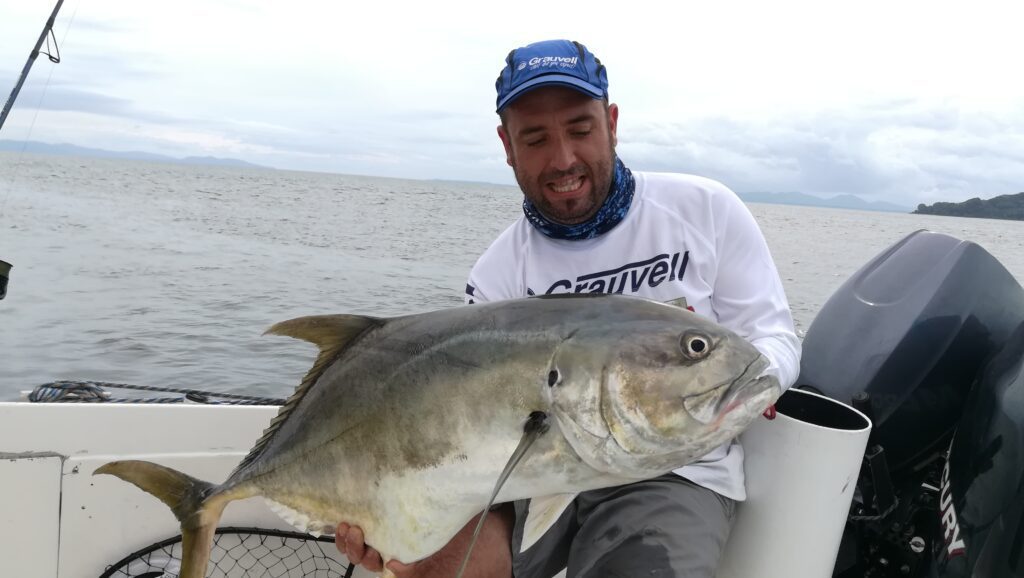
If you prefer a more relaxed fishing experience close to the coast or around a mangrove area, Panama’s inshore waters offer abundant opportunities. Roosterfish, known for their distinctive appearance and aggressive strikes, are a popular target among anglers. These hard-fighting fish can be found along the Pacific coast and provide an exciting challenge for anglers of all levels.
Snapper species, including cubera snapper and Pacific red snapper, are also highly sought after in Panama’s inshore waters. These bottom-dwelling fish offer thrilling battles and are known for their delicious taste.
Other inshore species you may encounter include yellow seabass, tarpon, jacks, snook, and grouper.
River and Lake Species
Panama’s river and lake fishing experiences are nothing short of extraordinary. Imagine yourself gently releasing your fishing line into the serene depths of Gatun Lake or the Chagres River, embraced by verdant rainforests and captivating wildlife within the renowned waters of the Panama Canal. The diverse ecosystems of Panama’s waterways offer a chance to reel in an impressive array of species, from peacock bass to snook and tarpon.
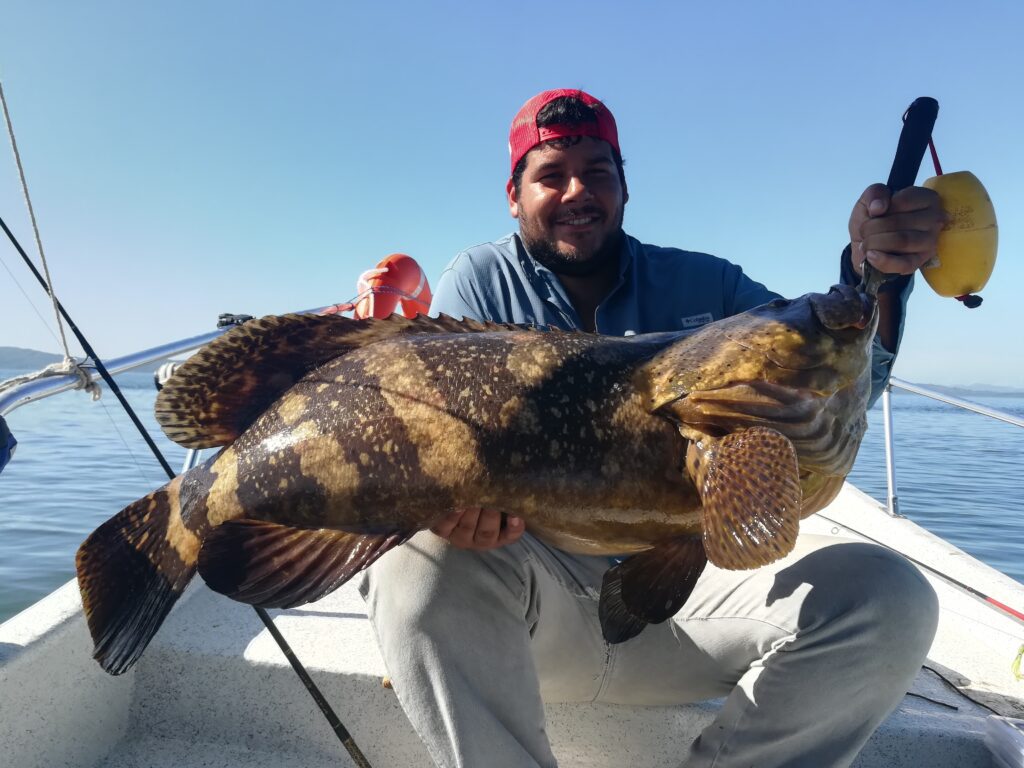

The photo above shows a baby grouper in the Gulf of Montijo. They reach a maximum of 2.5 m (8 feet 2 inches) in length and 309 kg (700 lbs) in weight.
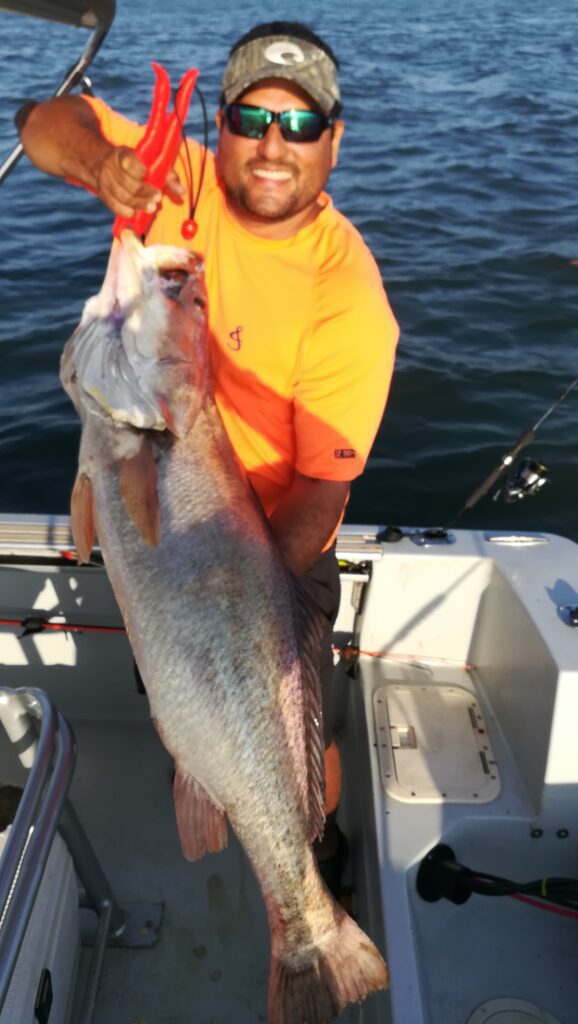

Surrounded by majestic mangroves, this vast gulf offers a captivating setting where marine life finds refuge as the nursery of the ocean. The dense mangrove forests, essential as cradles of marine life and natural filters, are home to an astonishing diversity of species, from juvenile fish to larger specimens that populate the deep waters. Among the aquatic gems that inhabit these waters are the hardy red snapper, the impressive groupers, the snook, the yellowtail jack, and the big yellow seabass.
Whether you’re an avid angler seeking a new challenge or someone looking to unwind in a serene natural setting, Panama’s river and lake fishing adventures are a must-try. Come and discover the thrill of fishing in this tropical paradise, and you’ll be hooked on Panama’s unparalleled fishing experiences for a lifetime.
Offshore Fishing in Panama: Chasing the Big Game
Offshore fishing in Panama is a thrilling experience that attracts anglers from around the world. The Pacific side of Panama offers incredible opportunities to target trophy-sized fish and chase world records.
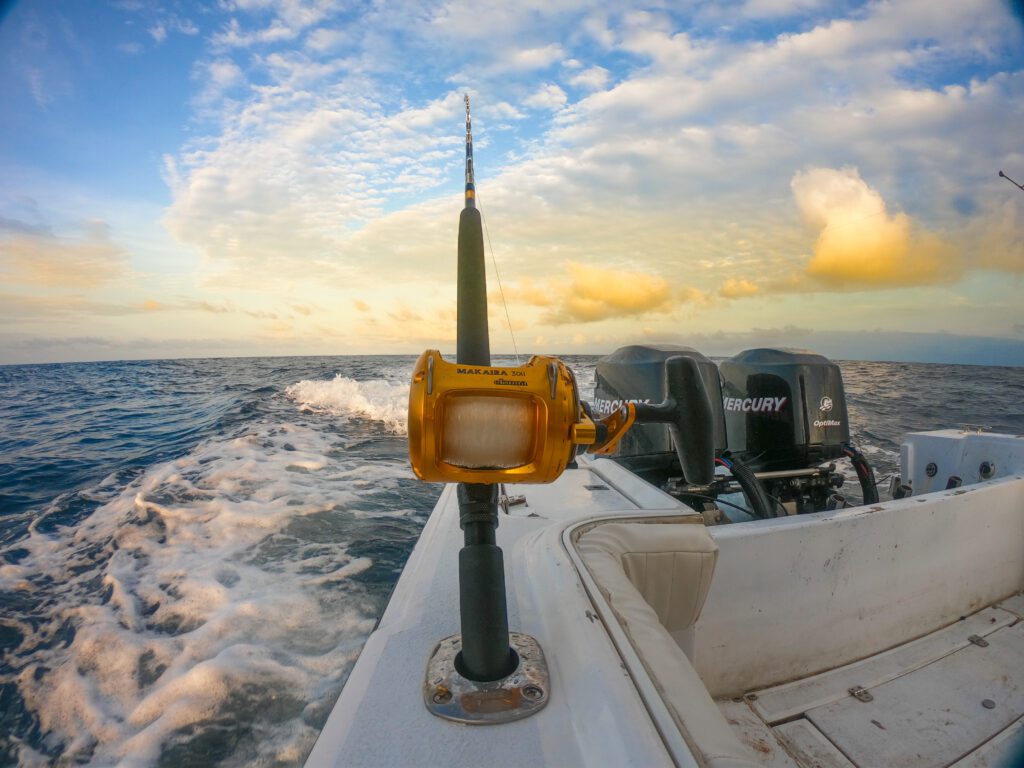

Although we don’t claim to foresee the specific fish that will be present in the area several months ahead, we’re delighted to provide insights into recent fishing activity and our expectations for the upcoming weeks leading to your trip.
Here are some key details about offshore fishing in Panama:
Top Offshore Fishing Locations in Panama
Panama is home to several renowned offshore fishing locations, each offering its own unique fishing experience. Here are a few top spots to consider:
- Hannibal Bank: Situated in the Gulf of Chiriquí, Hannibal Bank is famous for its trophy-sized black marlin and yellowfin tuna. Anglers flock to this underwater mountain for a chance to battle these powerful giants.
- Coiba Island: Coiba National Park, a UNESCO World Heritage Site, is a premier offshore fishing destination. Its pristine waters are home to an abundance of fish species, including marlin, sailfish, wahoo, and dorado. Coiba Island is also known for its extraordinary biodiversity, making it a paradise for nature lovers.
- Cebaco Island and Mariato Coast: On the coasts of Mariato, Cebaco Island, and all surrenders, there is a long coastline with an abundance of marine fauna every month of the year. Here, fishing becomes an exceptional sport because the species that can be caught are exotic and coveted, like dorado (mahi-mahi), yellowfin tuna, sailfish, and many other game fish.
- Pearl Islands: Located in the Gulf of Panama, the Pearl Islands offer a wealth of offshore fishing opportunities. Here, you can target marlin, tuna, sailfish, and other game fish while enjoying the breathtaking beauty of the islands.
- Pedasi Coast, called “The Tuna Coast“: is located in one of the best places in the world for fishing. Pelagic game fish are abundant because the continental shelf drops sharply, relatively close to shore. Year-round catch includes amberjack, marlin, Pacific sailfish, cubera snapper, roosterfish, and grouper, while dorado (commonly called mahi-mahi, or dolphinfish), yellowfin tuna, and wahoo are found seasonally, November through April.
Offshore Fishing Techniques, Strategies and Tackle Gear
When engaging in offshore fishing in Panama, there are various strategies and equipment options to enhance your chances of success. Trolling stands out as a favored technique for pursuing pelagic species like marlin and sailfish. Achieving great results can involve high-speed trolling using artificial lures or adopting a slower approach with live bait.
Selecting the right gear is crucial for offshore fishing, given the pursuit of large and powerful fish. Essential components include robust rods and reels designed to handle significant drag pressures. It’s also advisable to opt for durable fishing lines, such as braided lines, capable of withstanding the intense battles with trophy-sized fish.
When is the Best Season for Offshore Fishing in Panama?
Offering a concise answer to this question is not straightforward, as the answer varies depending on individual preferences, priorities, and fishing goals. Below, we offer a general guideline to assist you in determining the most suitable season for your needs. We also encourage our repeat customers to consider exploring a different time of year to discover unique fishing experiences and fully immerse themselves in the diverse opportunities that Panama has to offer over time.
Fishing in Panama’s Green Season
The best time for offshore fishing in Panama is generally during the wet season, which runs from the ends of April to December; we call it “The Green Season.” During these months, we do not have strong winds and therefore better conditions for sailing, and the seas are mostly flat, providing optimal conditions for deep-sea fishing. However, it’s important to note that Panama’s waters offer excellent fishing opportunities year-round, and each season brings its own unique species and fishing conditions.
In this season, we witness an increase in the presence of pelagic species that venture nearer to the shoreline. Among these, the yellowfin tuna, spanning various sizes, typically begin making their appearance in May, with their numbers and size steadily growing as we progress into the peak tuna season during July, August, and September.
In June, you can expect a slightly higher frequency of rain, but the presence of black marlin and yellowfin tuna remains abundant. July and August bring rain and occasional thunderstorms, along with ample opportunities to catch dorado fish. Moving into September, you’ll notice an increase in rain, but the dorado fishing remains excellent.
From August on, the wahoo (Petos) showed up in some fishing spots and is one of the most coveted fish in sport fishing due to its flavor and challenging catch. They tend to be solitary or occur in loose-knit groups of two or three fish, but where conditions are suitable, they can be found in schools as large as 100 or more. Their diet is made up of other fish and squid.
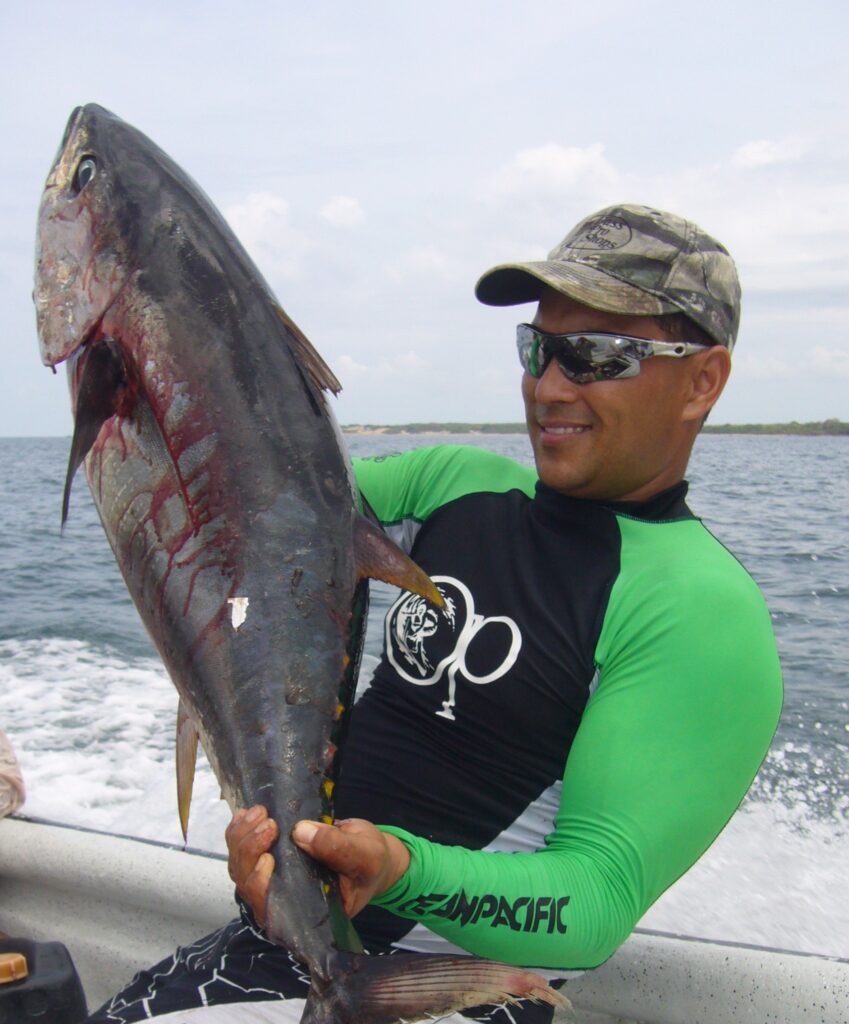

This is also the best time for a chance at a trophy roosterfish, cubera snapper, or both, close to the rocky formation.
Fishing in Panama in Windy Season
The end of December is the beginning of the dry or windy season. During this time, we experience strong winds from the north and cooler current water temperatures. Water conditions are choppy due to these winds, and with them come high currents and a high presence of nutrients. Large schools of small fish appear as bait balls in our waters, and behind them come big predators like the Black Marlin.
February is even better; blue, black, and striped marlin are all popular catches during this month, and inshore Panama fishing really picks up with cubera snapper and rooster fish as part of a typical day’s price.
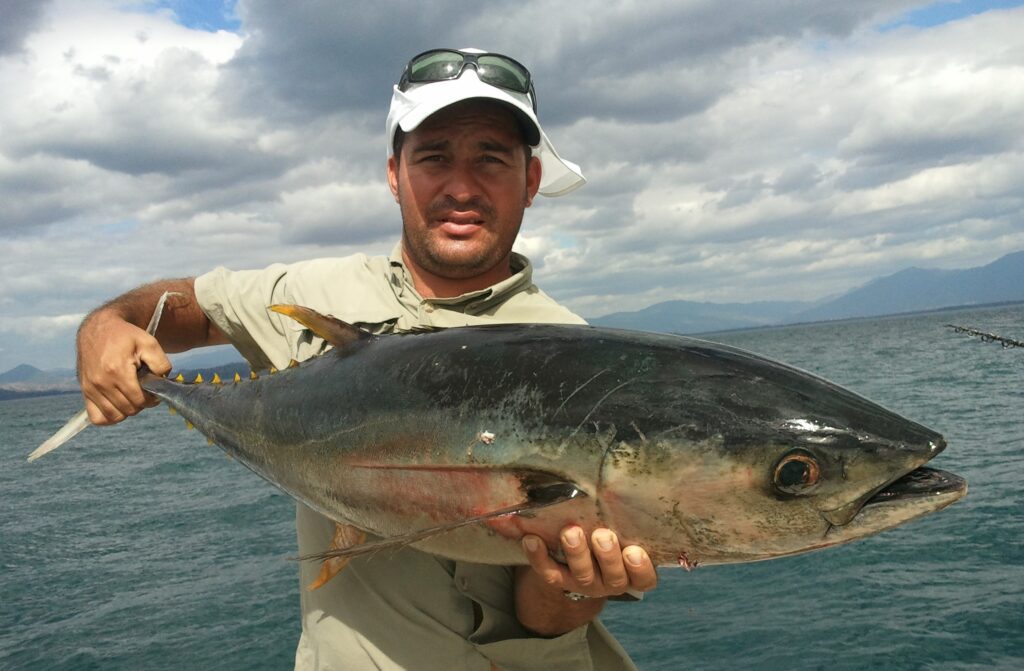

March is another story. Frenzies involving small to medium-tasting tuna are common, making this one of the best months for fishing and cooking. The marlins and sailfish are still there, and strong windy days and cold water temperatures are common throughout the month.
In the first days of April, the wind begins to calm down, with much calmer seas and a little bit warmer water temperatures. The yellow fin tuna madness begins, and jigging is a reproductive tactic that takes advantage of the colder water temperatures.
Inshore Fishing: Exploring the Panama Coastal Wonders
While the limelight often focuses on offshore fishing, Panama’s inshore waters provide a distinctive charm and excitement of their own. Exploring the picturesque coastal areas, targeting a diverse array of species, and relishing a more laid-back fishing experience are some of the enticing aspects of inshore fishing in Panama. Here’s a guide to enhance your understanding of this rewarding activity:
Panama: The Best Time for Inshore Fishing
Inshore fishing in Panama can be enjoyed year-round, although certain seasons present more favorable conditions for specific species. Typically, the dry season spanning from December to April is regarded as optimal for inshore fishing due to pleasant weather and clearer waters. Nevertheless, each season brings its own unique attractions, ensuring anglers can anticipate thrilling encounters regardless of the time of year.
Panama: Top Inshore Fishing Locations
- Gulf of Chiriquí: Known for its stunning natural beauty and diverse marine life, the Gulf of Chiriquí offers exceptional inshore fishing opportunities. You can target roosterfish, snapper, grouper, and other species while enjoying the scenic surroundings of this tropical paradise.
- Bocas del Toro: Situated on the Caribbean side of Panama, Bocas del Toro is renowned for its vibrant coral reefs, crystal-clear waters, and abundant marine life. Inshore fishing enthusiasts can target snook, tarpon, jacks, and a variety of reef fish in this picturesque archipelago.
- Panama Canal: Even in the bustling capital city, anglers can find rewarding inshore fishing experiences. The nearby Causeway Islands and the Panama Canal’s freshwater lakes offer opportunities to catch snapper, tarpon, jacks, and other species while enjoying the city’s skyline views.
- Gulf of Montijo: Nestled in Panama’s province of Veraguas, the Gulf of Montijo emerges as an enchanting paradise for both seasoned anglers and nature enthusiasts. This untouched haven, enriched by vibrant biodiversity and the breathtaking grandeur of its towering mangroves, invites exploration into a world of thrilling sport fishing. The Gulf of Montijo is famed for its rich fish population, encompassing species such as red snapper, groupers, snook, and massive yellow bass, among others.
Inshore Fishing Techniques, Strategies and Tackle Gear
Inshore fishing necessitates a distinct set of strategies and gear when compared to offshore fishing. Commonly employed methods for targeting inshore species include casting and jigging. Casting artificial lures, such as topwater plugs or soft plastics, proves effective in provoking aggressive strikes from species like roosterfish and snook. Meanwhile, jigging with metal or bucktail jigs is successful in enticing bottom-dwelling species such as snapper and grouper.
Medium spinning or casting rods, paired with reels tailored for the targeted species, are typically utilized in inshore fishing. It’s crucial to match your gear to the size and fighting capabilities of the fish you anticipate encountering. Moreover, employing fluorocarbon leaders and appropriately sized hooks enhances the likelihood of a successful catch.
Conservation and Sustainable Fishing Practices
We are committed to preserving Panama’s diverse marine biodiversity and promoting sustainable fishing practices. As an angler, I recognize the importance of contributing to conservation efforts to ensure the long-term health of our fishing resources. Here are some key principles I adhere to for sustainable fishing in Panama:
• Practice catch and release: Whenever possible, we release fish unharmed, particularly those belonging to species with vulnerable populations.
• We respect size and quantity limits. We are familiar with local fishing regulations and strictly adhere to the limits specified for each species.
• Use circle hooks: I opt for circle hooks designed to minimize deep hooking, thereby increasing the chances of survival for released fish.
• Minimize unnecessary harm: I handle fish with care, reduce their time out of the water, and use suitable tools for hook removal to minimize harm.
• Support local conservation initiatives: I actively contribute to organizations and projects dedicated to preserving marine ecosystems and promoting sustainable fishing practices.
By adopting these principles, I play a role in the ongoing sustainability of fishing in Panama, ensuring that future generations can also enjoy its natural wonders.
Making a Fishing Reservation
By planning ahead anticipating and taking into account these factors in advance, you can ensure a fishing trip to Panama that is smooth and enjoyable.
For more Fishing Information o Book your next fishing trip, just follow the link: https://www.pacificadvent.com/get-hooked-fishing-panama-an-exciting-adventure/
